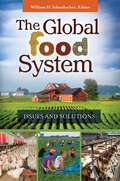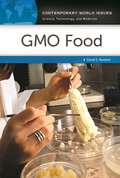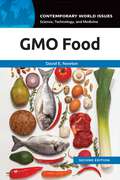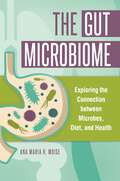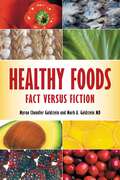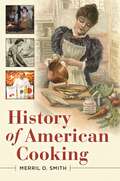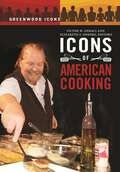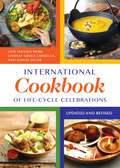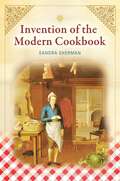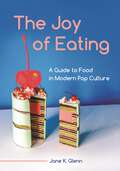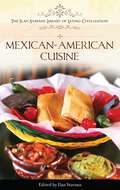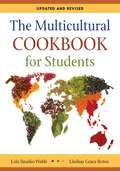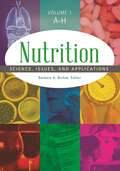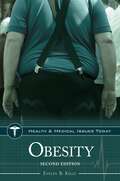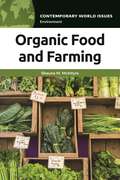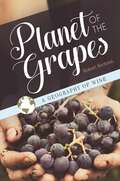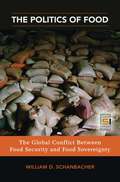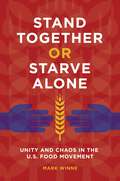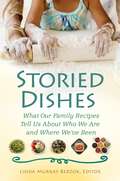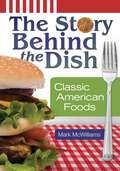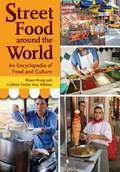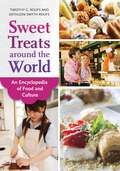- Table View
- List View
The Global Food System: Issues and Solutions
by William D. Schanbacher, EditorThis detailed analysis of the global food system looks at the way food is produced, distributed, and consumed in an effort to create a more equitable and healthful system worldwide.With large-scale famine afflicting regions around the globe and overconsumption and unhealthy eating habits destroying others, many are beginning to wonder if access to food is less of a class-based social problem and more of an ethical issue affecting the lives—and livelihoods—of people all over the world. This thoughtful text provides a thorough examination of the factors contributing to this global concern, exploring the complexities of international food supply and demand as well as the efforts to bring about a more just global food system.Through this groundbreaking volume, author and educator Will Schanbacher sheds light on flaws in the current structure and suggests ways to achieve a more balanced approach. He considers the economics, politics, and activism behind and involved in the production, distribution, and consumption of the global food system. In an effort to illuminate many problems associated with hunger, inequality, and injustice in the food system, the book also offers many potential strategies and solutions for making a more healthy, sustainable, and equitable world. Chapters contain both theoretical models and concrete practices for food security and offer strategies for creating an equitable system.
GMO Food: A Reference Handbook (Contemporary World Issues)
by David E. NewtonProviding an exhaustive background on the history of genetically modified organism (GMO) crops and foods as well as the controversies surrounding these products, this book allows readers to develop their own particular viewpoint on the production and use of GMO substances.Genetic engineering has long been used to impart desirable characteristics to food plants in order to improve crop yield, pest resistance, and herbicide tolerance. Genetic modification of foods, however, has created a storm of controversy everywhere in the world—including the United States. What are the benefits of and risks involved with genetically modified organisms (GMO) and crops? What powerful industry pressures have extended the sale and use of GMO foods and crops globally? And how should consumer food products that involve GM ingredients be labeled? GMO Food: A Reference Handbook addresses these questions and the complex issues involved, allowing readers to fully understand why genetically modified organisms represent one of the most important issues in the 21st century.The book provides clear, factual information and background on the history of genetically modified crops and foods, covering topics such as the historic methods of plant and animal modification (such as cross-breeding) and important discoveries in genetics, biochemistry, molecular biology, genetic engineering, and related fields; the social, political, philosophical, and economic issues that have arisen with these scientific advances; and the laws and regulations that have resulted from the range of attitudes about GMO foods. The book also supplies additional resources for readers performing extensive research in an annotated bibliography of books, articles, reports, and web pages.
GMO Food: A Reference Handbook (Contemporary World Issues)
by David E. NewtonGMO Food: A Reference Handbook offers an in-depth discussion of genetically modified food. It covers the history of, opposition to, regulation of, and labeling of genetic modifications, along with the potential benefits and harm involved.GMO Food: A Reference Handbook is intended to serve as a research guide for young adults in high school and beyond. Students at all grade levels should be able to use the book as an introduction to the history of genetic engineering of organisms and the use of this technology for the development of new forms of crops and foods.They will learn briefly about historic methods of plant and animal modification (such as cross-breeding) and, in more detail, how discoveries since the late nineteenth century have greatly changed the process of plant and animal modification. These discoveries include important steps forward in genetics, biochemistry, molecular biology, genetic engineering, and related fields. They will also learn about the variety of social, political, philosophical, economic, and other issues that have arisen alongside these scientific advances, as well as about some of the laws, regulations, and other solutions that have been developed for dealing with the range of attitudes about genetically modified foods. The second edition covers developments since 2014.
The Gut Microbiome: Exploring the Connection between Microbes, Diet, and Health
by Ana Maria MoiseThis accessibly written, comprehensive summary of research findings on the gut microbiome and its implications for health and disease—a topic of growing interest and concern—serves as an essential resource for teachers and students.Most people know that the digestive tract contains billions of helpful gut bacteria, but how does the gut microbiome affect our health? What exactly do these bacteria do, and what are the negative effects when these microorganisms are harmed by what we eat and do? What impacts might they have on conditions such as irritable bowel syndrome (IBS), obesity, and autism? This book provides an accessible, holistic introduction to the study of the human gut microbiome and its effects on digestion and disease—one of the newest and most rapidly expanding fields in medicine today.The gut microbiome is known as "the forgotten organ" because it is not identified as part of the human body per se, yet it has an immense influence on many systems in the body. The Gut Microbiome: Exploring the Connection between Microbes, Diet, and Health explains what the microbiome is, the many functions it serves, how it can be either harmed or supported by our actions, and the role it may play in various diseases and in determining our overall health. The book examines the various potential causes of imbalance in the microbiome, such as diet and other lifestyle factors, and then identifies strategies for improving human health by protecting the gut microbiota. The science-based information is detailed but accessible to general readers or students without extensive background knowledge.
Healthy Foods: Fact versus Fiction
by Myrna Chandler Goldstein Mark A. MDThis book presents research findings about 50 foods that are commonly touted as healthy and educates readers about the medical problems they purportedly alleviate or help prevent.It is always in the best interest of those who market foods to make grandiose claims regarding their nutritional value, regardless of whether actual scientific proof exists to support such a claim. Even diligent and educated consumers often have difficulty discerning facts from mere theory or pure marketing hype.As the incidence of childhood obesity in the United States continues to increase at an alarming rate and food costs skyrocket, this book arrives at a perfect time for health-conscious consumers, providing an authoritative reference for anyone looking to make wise eating decisions at home, work, school, or in restaurants. Healthy Foods: Fact versus Fiction is the result of a collaborative effort between a medical doctor and an award-winning journalist and author on nutrition. This book provides actual research findings to shed light on the true benefits of the most popular health foods—and in some cases, debunk misconceptions surrounding certain foods.
History of American Cooking
by Merril D. SmithIdeal for American history and food history students as well as general readers, this book spans 500 years of cooking in what is now the United States, supplying recipes and covering the "how" and "why" of eating.This book examines the history and practice of cooking in what is now the United States from approximately the 15th century to the present day, covering everything from the hot-stone cooking techniques of the Nootka people of the Pacific Northwest to the influence of Crisco—a shortening product intended as a substitute for lard—upon American cooking in the 20th century. Learning how American cooking has evolved throughout the centuries provides valuable insights into life in the past and offers hints to our future.The author describes cooking methods used throughout American history, spotlighting why particular methods were used and how they were used to produce particular dishes. The historical presentation of information will be particularly useful to high school students studying U.S. history and learning about how wartime and new technology affects life across society. General readers will enjoy learning about the topics mentioned above, as well as the in-depth discussions of such dishes as fried chicken, donuts, and Thanksgiving turkey. Numerous sample recipes are also included.
Icons of American Cooking (Greenwood Icons)
by Victor W. Geraci Elizabeth S. Demers, EditorsDiscover how these contemporary food icons changed the way Americans eat through the fascinating biographical profiles in this book.Before 1946 and the advent of the first television cooking show, James Beard's I Love to Eat, not many Americans were familiar with the finer aspects of French cuisine. Today, food in the United States has experienced multiple revolutions, having received—and embraced—influences from not only Europe, but cultures ranging from the Far East to Latin America. This expansion of America's appreciation for food is largely the result of a number of well-known food enthusiasts who forever changed how we eat. Icons of American Cooking examines the giants of American food, cooking, and cuisine through 24 biographical profiles of contemporary figures, covering all regions, cooking styles, and ethnic origins. This book fills a gap by providing behind-the-scenes insights into the biggest names in American food, past and present.
International Cookbook of Life-Cycle Celebrations
by Lois Sinaiko Webb Lindsay Grace Cardella Jeanne JacobMuch more than a cookbook offering a breadth of delicious recipes that honor ethnic traditions and religious customs, this text provides readers with an understanding and appreciation of customs and rites of passage from around the world.International Cookbook of Life-Cycle Celebrations takes readers on a journey around the world and back with an overview of religious customs, specific cultural traditions, and delicious recipes. Readers will learn about unique customs and traditions from more than 150 countries relevant to birth celebrations to weddings to funeral rituals. Although the text is rich with detail, the presentation of information is accessible to general readers and the recipes are kept simple so students of all ages and cooking abilities can execute the dishes and enjoy the results. Organized by continent, region, and then country, the book begins with an overview of religious customs as well as safety and cleanliness tips for cooks. After the introduction, the chapters present information on each country with the specific customs and recipes that correspond to that ethnicity's traditions. The recipes are easy to follow and provide alternatives to complex or hard-to-find ingredients that can be used without jeopardizing the flavor and taste of the end result.
Invention of the Modern Cookbook
by Sandra ShermanThis eye-opening history will change the way you read a cookbook or regard a TV chef, making cooking ventures vastly more interesting—and a lot more fun.Every kitchen has at least one well-worn cookbook, but just how did they come to be? Invention of the Modern Cookbook is the first study to examine that question, discussing the roots of these collections in 17th-century England and illuminating the cookbook's role as it has evolved over time.Readers will discover that cookbooks were the product of careful invention by highly skilled chefs and profit-minded publishers who designed them for maximum audience appeal, responding to a changing readership and cultural conditions and utilizing innovative marketing and promotion techniques still practiced today. They will see how cookbooks helped women adjust to the changes of the Enlightenment and Industrial Revolution by educating them on a range of subjects from etiquette to dealing with household servants. And they will learn how the books themselves became "modern," taking on the characteristics we now take for granted.
The Joy of Eating: A Guide to Food in Modern Pop Culture
by Jane K. GlennThis volume explores our cultural celebration of food, blending lobster festivals, politicians' roadside eats, reality show "chef showdowns," and gravity-defying cakes into a deeper exploration of why people find so much joy in eating.In 1961, Julia Child introduced the American public to an entirely new, joy-infused approach to cooking and eating food. In doing so, she set in motion a food renaissance that is still in full bloom today. Over the last six decades, food has become an increasingly more diverse, prominent, and joyful point of cultural interest. The Joy of Eating discusses in detail the current golden age of food in contemporary American popular culture. Entries explore the proliferation of food-themed television shows, documentaries, and networks; the booming popularity of celebrity chefs; unusual, exotic, decadent, creative, and even mundane food trends; and cultural celebrations of food, such as in festivals and music. The volume provides depth and academic gravity by tying each entry into broader themes and larger contexts (in relation to a food-themed reality show, for example, discussing the show's popularity in direct relation to a significant economic event), providing a brief history behind popular foods and types of cuisines and tracing the evolution of our understanding of diet and nutrition, among other explications.
Mexican-American Cuisine (The Ilan Stavans Library of Latino Civilization)
by Ilan StavansProviding food for the brain as well as the body, this wonderful collection of essays explores the boundaries between Mexican and Mexican-American foods, promotes philosophical understandings of Mexican-American cuisine, and shares recipes from both past and present.Defining Mexican-American food is difficult due to its incredibly diverse roots and traditions. This unique style of cuisine varies significantly from Mexican and Latin American cuisines, fusing Native American and Hispanic influences stemming from three centuries of first Spanish and later Mexican rule. In Mexican-American Cuisine, renowned authority in Latino culture Ilan Stavans and 10 other experts in southwestern cuisine explore the food itself and associated traditions.The book presents nine scholarly essays that examine philosophical understandings of Mexican-American cuisine. Covering both platillos principales (main dishes) and postres (desserts), the authors serve up a sideboard of anthropological, ethnographic, sociological, and culinary observations. Essay topics include the boundaries between Mexican and Mexican-American food, the history and uses of the chile, and the derivations of Mexican cuisine. Readers are also treated to recipes and recommendations by 19th-century California chef Encarnación Pinedo who explores "The Art of Cooking."
The Multicultural Cookbook for Students
by Lois Sinaiko Webb Lindsay Grace CardellaAn updated and revised edition of the much-requested global cookbook designed to introduce students to worldwide foodways.When it was first published, The Multicultural Cookbook for Students was widely acclaimed for its unique way of introducing students both to world cultures and to the kitchen. Now, that landmark volume returns in a thoroughly revised and expanded new edition, offering an even richer culinary tour of the planet with more delectable stops along the way.The Multicultural Cookbook for Students: Updated and Revised offers hundreds of recipes from over 150 countries—including 140 new recipes to this edition. Recipes are arranged geographically by region, then country of origin. For each country, the book offers one to three recipes as well as a brief introduction to that location's geography, history, and culinary traditions. Students will not only enjoy deliciously diverse eating, they will understand why these dishes are representative of the countries they originate from. They will also get expert training in the ways of the kitchen, with easy-to-follow recipe instructions, and advice on safety, cooking equipment, and appropriate substitutions for more exotic ingredients.
Nutrition [2 volumes]: Science, Issues, and Applications [2 volumes]
by Barbara A. Brehm, EditorThis thorough one-stop resource draws on solid science and the latest research to play a dual educational role—providing background for students while answering general readers' questions about a wide range of nutrition-related topics.Nutrition is a popular but often misunderstood topic, one about which there is a great deal of interest as evidenced by the plethora of available advice. Because nutrition is a key factor in health, it is important that the public have a source of information they can trust. This is that source: a comprehensive overview that will help readers make sense of conflicting information they find in the media regarding what is healthy and what is not. Organized alphabetically, the two-volume work covers the most important topics in human nutrition including nutrients, nutrition-related health concerns, aging and nutrition, eating disorders, and the value of dietary supplements. The digestive system and its organs are discussed, with particular attention to health issues such as irritable bowel syndrome and the role of helpful bacteria. The physiology of hunger and the psychology of appetite and eating behaviors are explained. The work also delves into data on foods that have been featured in recent research, such as garlic, ginger, and turmeric, and it offers consumers a clearer understanding of nutrition-related practices such as organic farming, genetically modified foods, and the use of food additives.
Obesity (Health and Medical Issues Today)
by Evelyn B. KellyThis book explores what obesity is, its causes and implications for health, and the many issues and controversies surrounding it, both in the medical community and within society as a whole.Obesity is defined as the state of having a body mass index (BMI) greater than 30. Although it may be easy to identify what obesity is, however, identifying its causes and effects can be more challenging. Genetic, hormonal, environmental, and behavioral factors all play a role in defining our weight, and the consequences of obesity go far beyond medical complications, to include impacts on psychological well-being and social health, and how we think about and address this growing epidemic has become just as controversial as it is important.This second edition of Obesity offers a wealth of new information and features. Coverage of genetic and hormonal causes of obesity has been greatly expanded, as has discussion of medications and surgical techniques to manage obesity. The book reflects our expanded scientific understanding of obesity and delves into medical and societal debates about weight that have emerged in recent years. Also new in this edition is a collection of case studies, each of which helps to make the topics discussed in the book more accessible to readers.
Obesity: A Reference Handbook (Contemporary World Issues)
by Judith S. Stern Alexandra KazaksObesity has reached epidemic proportions in countries like the United States. This book provides a comprehensive summary of obesity in America and around the world, discussing the causes and proposing ways to help stem the tide and to help those who are overweight.A highly useful and accessible resource for high school to undergraduate students as well as post-graduate level readers with an interest in health and nutrition, this updated second edition of Obesity: A Reference Handbook offers up-to-date answers to essential questions about obesity and connected societal and health care-related issues. A single-volume, go-to resource, this book addresses difficult questions such as whether obesity is a disease or a moral failing; what factors contribute to obesity; what the economic impacts of obesity are on the health care industry; if and how poverty is a contributor to obesity; how our society encourages obesity; and how changes can be made to improve our society's eating habits as a whole. It presents citations from individuals and peer-reviewed journals and review articles, providing a balance of information sourced from both professionals and informed lay commentators. Also included are dozens of biographies of individuals who have been important in studying, preventing, managing, or increasing awareness about obesity, such as Jared Fogle, longtime Subway sandwiches spokesperson; Kelly Brownell, who coined the phrase "toxic environment" to describe unhealthy food and exercise patterns; researcher Ethan Allen Sims, who examined the relationship between obesity and diabetes; and Oprah Winfrey, well-known celebrity who stated that if there were a pill to lose weight or a magic diet, she would have it.
Obesity: Your Questions Answered (Q&A Health Guides)
by Christine L. SelbyThis book serves as an accessible resource for teens who want to learn more about obesity. The information and guidance it offers make it a valuable tool for young adult readers with questions or concerns about their weight.Obesity—represented by a BMI over 30—may be easy to define, but its causes and consequences and how individuals and agencies should address it are not as clear. Is obesity simply the result of eating more calories than one burns, or are other factors involved? Can an individual be obese and healthy? How does obesity affect psychological and social health? Are public health campaigns targeted at reducing obesity helping or hurting? Obesity: Your Questions Answered, a part of Greenwood's Q&A Health Guides series, answers these and other questions related to this high-interest topic. Each book in this series follows a reader-friendly question-and-answer format that anticipates readers' needs and concerns. Prevalent myths and misconceptions are identified and dispelled, and a collection of case studies illustrates key concepts and issues through relatable stories and insightful recommendations. The book also includes a section on health literacy, equipping teens and young adults with practical tools and strategies for finding, evaluating, and using credible sources of health information both on and off the internet—important skills that contribute to a lifetime of healthy decision-making.
Organic Food and Farming: A Reference Handbook (Contemporary World Issues)
by Shauna M. McIntyreOrganic Food and Farming: A Reference Handbook is a valuable resource for students and general readers curious about the history, evolution, and growth of the organic food movement.Organic Food and Farming: A Reference Handbook begins with a deep dive into the origins of organic farming, offering a clear discussion of what constitutes organic production and how that has changed over time. Next, the volume provides a comprehensive overview of growth of organics as both an industry and a social movement and the inherent challenges that occur from trying to be both. The book additionally covers controversial issues and challenges, along with good news about what is working and what is possible. Included are essays by scholars, farmers, and experts working with NGOs as well as profiles of key people and organizations in the organic sector. Additional chapters include data and documents, a comprehensive resource list, and a detailed chronology of the key events in the history of the organic sector. Distinguishing it from others that laud or dismiss organic food and farming practices is this book's objective nature, which allows it to be used as a definitive resource on the topic.
Planet of the Grapes: A Geography of Wine
by Robert SechristA fascinating and comprehensive introduction to the geography, culture, and history of wine that identifies the significance of this simple beverage throughout human history and today.Wine was one the key founding foods of Western culture (bread and oil being the other two). It has played a key role in human history for thousands of years, having been used for enjoyment, rituals, and religious purposes; today, the production and consumption of wine is a billion-dollar industry that plays an important role in the global economy. Planet of the Grapes: A Geography of Wine provides an interesting and accessible lens through which students can learn about geography, culture, society, history, religion, and the environment. The chapters cover the historical geography of wine, document how drinking wine has often been condemned as a vice, and describe wines by region and type, thereby providing a cultural geography of wine.Readers will learn about the historical geography of wine, terroir (the environmental conditions that affect grape crops), grape biogeography, the process of winemaking from a geographic perspective, the economic global significance of the wine trade, the ongoing love-hate relationship between wine and government, and what makes individual wine regions distinct. The content is written to be comprehensible to individuals without detailed previous knowledge about wine but provides detailed information and insight that wine connoisseurs will find engaging. Additionally, through the story of wine comes a unique telling of the social transformations in America that have resulted from sources such as anti-immigrant sentiment, pseudoscience, and censorship.
The Politics of Food: The Global Conflict between Food Security and Food Sovereignty (Praeger Security International)
by William D. SchanbacherA description of the current global food system, this book challenges our ethical responsibility to the global poor and implicates us all for failing to curb global hunger and malnutrition.The Politics of Food: The Global Conflict between Food Security and Food Sovereignty argues that our current global food system constitutes a massive violation of human rights.In this impassioned, well-researched book, William Schanbacher makes the case that the food security model for combating global hunger—driven by the United Nations, the World Bank, the International Monetary Fund, and other organizations—is a failure, too dependent on trade and too reliant on international agribusiness. Instead, the emerging model of food sovereignty—helping local farmers and businesses produce better quality food—is the more effective and responsible approach. Through numerous case studies, the book examines critical issues of global trade and corporate monopolization of the food industry, while examining the emerging social justice movements that seek to make food sovereignty the model for battling hunger.
Stand Together or Starve Alone: Unity and Chaos in the U.S. Food Movement
by Mark WinneAmerica has a perplexing, multifaceted problem that combines hunger, obesity, and unhealthy food. This book examines how this situation was created and shows how people working together can resolve this longstanding issue.The United States—one of the world's wealthiest and resource-richest nations—has multiple food-related problems: declining food quality due to industrialization of its production, obesity across all age groups, and a surprisingly large number of households suffering from food insecurity. These issues threaten to shorten the lives of many and significantly reduce the quality of life for millions of others. This book explores the root causes of food-related problems in the 20th and 21st centuries and explains why collective impact—the social form of working together for a common goal—is the method that needs to be employed to reach a successful resolution to hunger, obesity, and the challenges of the industrial food system. Authored by Mark Winne, a 45-year food activist, the book begins with background information about the evolution of the U.S. food movement since the 1960s that documents its incredible growth and variety of interests, organizations, and sectors. The subsequent sections demonstrate how these divergent interests have created a lack of unity and constitute a deterrent to achieving real change and improvement. Through examples from specific cities and states as well as a discussion of group dynamics and coalition-building methods, readers will come away with an understanding of a complicated topic and grasp the potential of a number of strategies for creating more cohesion within the food movement—and realizing meaningful improvements in our food system for current and future generations.
Starbucks (Corporations That Changed the World)
by Marie A. BussingSince its humble beginnings at Seattle's Pike Place Market in 1971, Starbucks has grown to become an industry leader and household name. This book takes an in-depth look at the evolution of this dynamic and sometimes controversial corporation.Americans drink 400 million cups of coffee every day, and many of them come from the thousands of Starbucks coffeehouses across the country. But how much do you really know about the place you get your morning cup of Joe?Part of Greenwood&’s Corporations That Changed the World series, this book provides readers with a richly detailed history of this famous coffeehouse chain. It traces StarbuckS&Rsquo; meteoric rise from a small Seattle-based company to an international powerhouse, chronicling how the changing executive leadership affected corporate strategy and direction. It also explores how Starbucks has embraced and incorporated new technologies and innovations, as well as how the corporation has shaped and been shaped by important social causes. An unbiased look at the controversies that have surrounded Starbucks over the years will help readers better understand these contentious issues. This updated and expanded edition includes new chapters, current financial data, and coverage of the COVID-19 pandemic's impact on the company.
Storied Dishes: What Our Family Recipes Tell Us About Who We Are and Where We've Been
by Linda Murray BerzokWe are what we eat—not just physiologically, but culturally. This collection of cross-cultural, generational essays, and accompanying recipes shows the profound importance of food dishes within American women's lives.For people of every ethnicity, food provides much more than mere fuel for the body—it contains an invisible component that ties families and generations together with the continuity of shared experience. And for the women who are entrusted with the responsibility of keeping that priceless cultural thread intact, family recipes embody tradition, bridge generation gaps, and erase age differences.This book is organized around 50 short essays and recipes presented by women from multicultural backgrounds and dissimilar walks of life. The chapters depict the paths of these individuals in their lives and the details of how they acquired their precious family recipes. The stories document how women universally use inherited family recipes to remember and memorialize key women in their lives and to aid and measure their own growth and development. Included are reminiscences of an Egyptian aunt, a poor mother from Australia, a Katrina-flooded New Orleans family, Turkish relations, Chinese mothers, and Indian grandmothers.
The Story Behind the Dish: Classic American Foods
by Mark McWilliamsProfiling 48 classic American foods ranging from junk and fast food to main dishes to desserts, this book reveals what made these dishes iconic in American pop culture.Americans have increasingly embraced food culture, a fact proven by the rising popularity of celebrity chefs and the prominence of television shows celebrating food themes. This fascinating overview reveals the surprising story behind the foods America loves.The Story Behind the Dish: Classic American Foods is an engaging pop culture resource which helps tell the story of American food. Each chapter is devoted to one of 48 distinctive American dishes and features the story of where the food developed, what inspired its creation, and how it has evolved. The book not only covers each food as a single entry, but also analyzes the themes and events that connect them, making the text useful as both a reference and a narrative on the history of food.
Street Food around the World: An Encyclopedia of Food and Culture
by Bruce Kraig Colleen Taylor Sen Fuad Ahmad Chitradeepa Anatharam Paula Arvela Rosemary Barron Manya Brachear Cynthia Clampitt Charlotte De Backer Monica Eng Clothilde Façon Rachel Finn Ove Fosså Olívia Fraga Shahrzad Ghorashian David Hammond Anissa Helou Richard Hosking Sharon Hudgins Phil Iddison Katrine Klinken Robert Launay Whitney Lingle Máirtín Mac Con Iomaire Ian Martin Laura Mason Marcela Mazzei Adrian Miller Katerina Nussdorfer Sarahlynn Pablo Gaitri Pagrach-Chandra Jorge Pérez Birgit Ricquier Nanna Rögnvaldardóttir Helen Saberi Heba Saleh María José Sevilla Mike Sula Richard Tan Aylin Öney Tan Viktorija Todorovska Karin Vaneker Paul Van Reyk Susan WeingartenIn this encyclopedia, two experienced world travelers and numerous contributors provide a fascinating worldwide survey of street foods and recipes to document the importance of casual cuisine to every culture, covering everything from dumplings to hot dogs and kebabs to tacos.Street foods run deep throughout human history and show the movements of peoples and their foods across the globe. For example, mandoo, manti, momo, and baozi: all of these types of dumplings originated in Central Asia and spread across the Old World beginning in the 12th century. This encyclopedia surveys common street foods in about 100 countries and regions of the world, clearly depicting how "fast foods of the common people" fit into a country or a region's environments, cultural history, and economy. The entries provide engaging information about specific foods as well as coverage of vendor and food stall culture and issues. An appendix of recipes allows for hands-on learning and provides opportunities for readers to taste international street foods at home.
Sweet Treats around the World: An Encyclopedia of Food and Culture
by Timothy G. Roufs Kathleen Smyth RoufsFrom apple pie to baklava, cannoli to gulab jamun, sweet treats have universal appeal in countries around the world. This encyclopedia provides a comprehensive look at global dessert culture.Few things represent a culture as well as food. Because sweets are universal foods, they are the perfect basis for a comparative study of the intersection of history, geography, social class, religion, politics, and other key aspects of life. With that in mind, this encyclopedia surveys nearly 100 countries, examining their characteristic sweet treats from an anthropological perspective. It offers historical context on what sweets are popular where and why and emphasizes the cross-cultural insights those sweets present. The reference opens with an overview of general trends in desserts and sweet treats. Entries organized by country and region describe cultural attributes of local desserts, how and when sweets are enjoyed, and any ingredients that are iconic. Several popular desserts are discussed within each entry including information on their history, their importance, and regional/cultural variations on preparation. An appendix of recipes provides instructions on how to make many of the dishes, whether for school projects or general entertaining.
